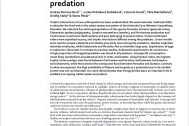Rok
2021Autoři
prof. Mgr. Stanislav Pekár, Ph.D.Druhy
Centromerus cavernarum (L. Koch, 1872) ESPorrhomma profundum M. Dahl, 1939 EN
Obsah
Trophic interactions of cave arthropods have been understudied. We used molecular methods (NGS) to decipher the food web in the subterranean ecosystem of the Ardovská Cave (Western Carpathians, Slovakia). We collected five arthropod predators of the species Parasitus loricatus (gamasid mites), Eukoenenia spelaea (palpigrades), Quedius mesomelinus (beetles), and Porrhomma profundum and Centromerus cavernarum (both spiders) and prey belonging to several orders. Various arthropod orders were exploited as prey, and trophic interactions differed among the predators. Linear models were used to compare absolute and relative prey body sizes among the predators. Quedius exploited relatively small prey, while Eukoenenia and Parasitus fed on relatively large prey. Exploitation of eggs or cadavers is discussed. In contrast to previous studies, Eukoenenia was found to be carnivorous. A high proportion of intraguild predation was found in all predators. Intraspecific consumption (most likely cannibalism) was detected only in mites and beetles. Using Pianka’s index, the highest trophic niche overlaps were found between Porrhomma and Parasitus and between Centromerus and Eukoenenia, while the lowest niche overlap was found between Parasitus and Quedius. Contrary to what we expected, the high availability of Diptera and Isopoda as a potential prey in the studied system was not corroborated. Our work demonstrates that intraguild diet plays an important role in predators occupying subterranean ecosystems.



